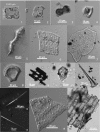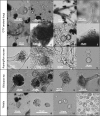The origins of specialized pottery and diverse alcohol fermentation techniques in Early Neolithic China
- PMID: 31160461
- PMCID: PMC6600912
- DOI: 10.1073/pnas.1902668116
The origins of specialized pottery and diverse alcohol fermentation techniques in Early Neolithic China
Abstract
In China, pottery containers first appeared about 20000 cal. BP, and became diverse in form during the Early Neolithic (9000-7000 cal. BP), signaling the emergence of functionally specialized vessels. China is also well-known for its early development of alcohol production. However, few studies have focused on the connections between the two technologies. Based on the analysis of residues (starch, phytolith, and fungus) adhering to pottery from two Early Neolithic sites in north China, here we demonstrate that three material changes occurring in the Early Neolithic signal innovation of specialized alcoholic making known in north China: (i) the spread of cereal domestication (millet and rice), (ii) the emergence of dedicated pottery types, particularly globular jars as liquid storage vessels, and (iii) the development of cereal-based alcohol production with at least two fermentation methods: the use of cereal malts and the use of moldy grain and herbs (qu and caoqu) as starters. The latter method was arguably a unique invention initiated in China, and our findings account for the earliest known examples of this technique. The major ingredients include broomcorn millet, Triticeae grasses, Job's tears, rice, beans, snake gourd root, ginger, possible yam and lily, and other plants, some probably with medicinal properties (e.g., ginger). Alcoholic beverages made with these methods were named li, jiu, and chang in ancient texts, first recorded in the Shang oracle-bone inscriptions (ca. 3200 cal. BP); our findings have revealed a much deeper history of these diverse fermentation technologies in China.
Keywords: ancient fermentation methods; fungi; millet; phytoliths; starch granules.
Conflict of interest statement
The authors declare no conflict of interest.
Figures





References
-
- Wang L., Sebillaud P., The emergence of early pottery in East Asia: New discoveries and perspectives. J. World Prehist. 32, 73–110 (2019).
-
- Yang X., et al. , Starch grain evidence reveals early pottery function cooking plant foods in north China. Chin. Sci. Bull. 59, 4352–4358 (2014).
-
- Liu L., Chen X., The Archaeology of China: From the Late Palaeolithic to the Early Bronze Age (Cambridge University Press, Cambridge, UK, 2012).
-
- Liu L., Zaoqi taoqi, zhuzhou, niangjiu yu shehui fuzahua de fazhan (Early pottery, porridge, and development of social complexity). Zhongyuan Wenwu 2, 24–34 (2017).
-
- Hornsey I. S., A History of Beer and Brewing (The Royal Society of Chemistry, Cambridge, UK, 2003).
Publication types
MeSH terms
LinkOut - more resources
Full Text Sources

